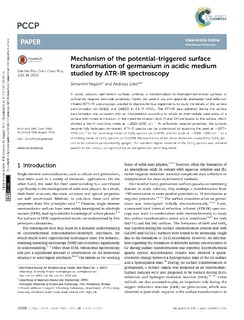| dc.contributor.author | Nayak, Simantini | |
| dc.contributor.author | Erbe, Andreas | |
| dc.date.accessioned | 2017-03-20T07:28:26Z | |
| dc.date.available | 2017-03-20T07:28:26Z | |
| dc.date.created | 2016-09-17T22:44:54Z | |
| dc.date.issued | 2016 | |
| dc.identifier.citation | Physical Chemistry, Chemical Physics - PCCP. 2016, 18 (36), 25100-25109. | nb_NO |
| dc.identifier.issn | 1463-9076 | |
| dc.identifier.uri | http://hdl.handle.net/11250/2434612 | |
| dc.description.abstract | In acidic solution, germanium surfaces undergo a transformation to hydrogen-terminated surfaces at sufficiently negative electrode potentials. Herein, we used in situ and operando attenuated total reflection infrared (ATR-IR) spectroscopy coupled to electrochemical experiments to study the details of this surface transformation on Ge(111) and Ge(100) in 0.1 M HClO4. The ATR-IR data gathered during the surface transformation are consistent with an interpretation according to which an intermediate state exists of a surface with mixed termination. In the mixed termination, both H and OH are bound to the surface, which showed a Ge–H stretching mode at ∼2025–2030 cm−1. At sufficiently negative potentials, the surfaces became fully hydrogen terminated. ATR-IR spectra can be understood by assigning the peak at ∼1977–1990 cm−1 to the stretching mode of GeH1 species on Ge(111), and the peak at ∼2000–2015 cm−1 to a stretching mode of GeH2 species on Ge(100). Measurements of the linear dichroism showed the GeH1 species to be oriented predominantly upright. The transition dipole moment of the GeH2 species was oriented parallel to the surface, as expected for an antisymmetric stretching mode. | nb_NO |
| dc.language.iso | eng | nb_NO |
| dc.publisher | Royal Society of Chemistry | nb_NO |
| dc.rights | Navngivelse-Ikkekommersiell 4.0 Internasjonal | * |
| dc.rights.uri | http://creativecommons.org/licenses/by-nc/4.0/deed.no | * |
| dc.title | Mechanism of the potential-triggered surface transformation of germanium in acidic medium studied by ATR-IR spectroscopy | nb_NO |
| dc.type | Journal article | nb_NO |
| dc.type | Peer reviewed | nb_NO |
| dc.source.pagenumber | 25100-25109 | nb_NO |
| dc.source.volume | 18 | nb_NO |
| dc.source.journal | Physical Chemistry, Chemical Physics - PCCP | nb_NO |
| dc.source.issue | 36 | nb_NO |
| dc.identifier.doi | 10.1039/c6cp04514f | |
| dc.identifier.cristin | 1382327 | |
| dc.description.localcode | This article is licensed under a Creative Commons Attribution-NonCommercial 3.0 Unported Licence. | nb_NO |
| cristin.unitcode | 194,66,35,0 | |
| cristin.unitname | Institutt for materialteknologi | |
| cristin.ispublished | true | |
| cristin.fulltext | postprint | |
| cristin.fulltext | original | |
| cristin.qualitycode | 2 | |

